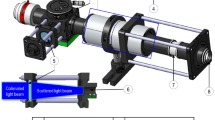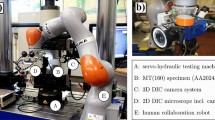Abstract
The measurement of machined-part strain fields induced by the cutting process remains a challenge because of the presence of highly intensive and localised strains. In this study, a high-speed double-frame imaging device with pulsed laser lighting is used in order to obtain sharp and highly resolved images during orthogonal cutting tests performed in an aluminium alloy. The displacement fields are then measured using a global Q4–digital-image-correlation (DIC) method and several strategies, facilitating calculation of the total displacements due to the cut, along with the residual strains in the machined part. Numerical procedures are developed to manage the removed material that disturbs the DIC. An automatic primary shear angle detection procedure using DIC is also proposed. Five different markings, which are produced via chemical etching and micro blasting, are applied to the observed surfaces. Their effects on the kinematic fields and the uncertainties are then studied. Three surface parameters are proposed as indicators for determining the surface preparation suitability for the DIC. The repeatability of the kinematic fields induced during the cutting process is studied, because of the ease with which testing can be performed. Finally, the plastically deformed layer engendered by the cutting process is measured using the calculated residual strains.










Similar content being viewed by others
References
Moussaoui K, Mousseigne M, Senatore J, Chieragatti R (2015) The effect of roughness and residual stresses on fatigue life time of an alloy of titanium. Int J Adv Manuf Technol 78(1):557–563
Gravier J, Vignal V, Bissey-Breton S (2012) Influence of residual stress, surface roughness and crystallographic texture induced by machining on the corrosion behaviour of copper in salt-fog atmosphere. Corros Sci 61:162–170
Denkena B, Grove T, Dittrich MA, Niederwestberg D, Lahres M (2015) Inverse determination of constitutive equations and cutting force modelling for complex tools using Oxley’s predictive machining theory. Procedia CIRP 31:405–410
Calamaz M, Coupard D, Girot F (2008) A new material model for 2d numerical simulation of serrated chip formation when machining titanium alloy Ti-6Al-4V. Int J Mach Tools Manuf 48(3-4):275–288
Mabrouki T, Girardin F, Asad M, Rigal JF (2008) Numerical and experimental study of dry cutting for an aeronautic aluminium alloy (A2024-T351). Int J Mach Tools Manuf 48(11):1187–1197
Chen G, Li J, He Y, Ren C (2014) A new approach to the determination of plastic flow stress and failure initiation strain for aluminum alloys cutting process. Comput Mater Sci 95:568–578
Wright PK, Horne JG, Tabors D (1979) Boundary conditions at the chip-tool interface in machning: comparison between seizure and sliding friction. Wear 54:371–390
Poulachon G, Moisan A (2000) Hard turning: Chip formation mechanisms and metallurgical aspects. J Manuf Sci Eng 122(3):406–412
Childs THC (1971) A new visio-plasticity technique and a study of curly chip formation. Int J Mech Sci 13(4):373–387
Sutter G (2005) Chip geometries during high-speed machining for orthogonal cutting conditions. Int J Mach Tools Manuf 45(6):719–726
Pujana J, Arrazola PJ, Villar JA (2008) In-process high-speed photography applied to orthogonal turning. J Mater Process Technol 202(1-3):475–485
Hijazi A, Madhavan V (2008) A novel ultra-high speed camera for digital image processing applications. Meas Sci Technol 19(8):085503
Arriola I, Whitenton E, Heigel J, Arrazola PJ (2011) Relationship between machinability index and in-process parameters during orthogonal cutting of steels. CIRP Ann Manuf Technol 60(1):93–96
List G, Sutter G, Bi XF, Molinari A, Bouthiche A (2013) Strain, strain rate and velocity fields determination at very high cutting speed. J Mater Process Technol 213(5):693–699
Pottier T, Germain G, Calamaz M, Morel A, Coupard D (2014) Sub-millimeter measurement of finite strains at cutting tool tip vicinity. Exp Mech 54:1031–1042
Sutton MA, Wolters WJ, Peters WH, Ranson WF, McNeill SR (1983) Determination of displacements using an improved digital correlation method. Image Vis Comput 1(3):133–139
Sutton MA, Orteu JJ, Schreier HW (2009) 5 Digital image correlation (DIC), Image Correlation for Shape, Motion and Deformation Measurements: Basic Concepts, Theory and Applications. Springer, US, pp 81–118
Bornert M, Hild F, Orteu JJ, Roux S (2012) 6 Digital Image Correlation. Wiley, pp 157–190. doi:10.1002/9781118578469.ch6
Besnard G, Hild F, Roux S (2006) Finite-Element displacement fields analysis from digital images: Application to Portevin - Le Chatelier̂ bands. Exp Mech 46(6):789–803
Hild F, Roux S (2012) Comparison of local and global approaches to digital image correlation. Exp Mech 52(9):1503–1519
Ghadbeigi H, Bradbury SR, Pinna C, Yates JR (2008) Determination of micro-scale plastic strain caused by orthogonal cutting. Int J Mach Tools Manuf 48(2):228–235
Ghadbeigi H, Pinna C, Celotto S (2012) Quantitative strain analysis of the large deformation at the scale of microstructure: Comparison between digital image correlation and microgrid techniques. Exp Mech 52(9):1483–1492
Hanson RK (1988) Planar laser-induced fluorescence imaging. J Quant Spectrosc Radiat Transf 40(3):343–362. special Issue on Quantitative Spectroscopy and Laser Diagnostics
Peterson PD, Mortensen KS, Idar DJ, Asay BW, Funk DJ (2001) Strain field formation in plastic bonded explosives under compressional punch loading. J Mater Sci 36(6):1395–1400
Zhang D, Zhang XM, Xu WJ, Ding H (2016) Stress field analysis in orthogonal cutting process using digital image correlation technique. J Manuf Sci Eng. doi:10.1115/1.4033928
Baizeau T, Campocasso S, Fromentin G, Rossi F, Poulachon G (2015) Effect of rake angle on strain field during orthogonal cutting of hardened steel with c-BN tools. Procedia CIRP 31:166–171
Outeiro JC, Campocasso S, Denguir LA, Fromentin G, Vignal V, Poulachon G (2015) Experimental and numerical assessment of subsurface plastic deformation induced by OFHC copper machining. CIRP Ann Manuf Technol 64(1):53–56
Oxley PLB (1962) Shear angle solutions in orthogonal machining. Int J Mach Tool Des Res 2(3):219–229
Lee E, Shaffer B (1951) The theory of plasticity applied to a problem of machining. J Appl Mech 18(4):405–413
Baizeau T, Campocasso S, Rossi F, Poulachon G, Hild F (2016) Cutting force sensor based on digital image correlation for segmented chip formation analysis. J Mater Process Technol. doi:10.1016/j.jmatprotec.2016.07.016
Buchkremer S, Klocke F, Lung D (2014) Analytical study on the relationship between chip geometry and equivalent strain distribution on the free surface of chips in metal cutting. Int J Mech Sci 85:88–103
Acknowledgments
The authors acknowledge the Institut Carnot ARTS for their financial support through the UsiCorSurf project. They also gratefully thank ADEME and NTN-SNR for their support through the WindProcess project.
Author information
Authors and Affiliations
Corresponding author
Rights and permissions
About this article
Cite this article
Baizeau, T., Campocasso, S., Fromentin, G. et al. Kinematic Field Measurements During Orthogonal Cutting Tests via DIC with Double-frame Camera and Pulsed Laser Lighting. Exp Mech 57, 581–591 (2017). https://doi.org/10.1007/s11340-016-0248-9
Received:
Accepted:
Published:
Issue Date:
DOI: https://doi.org/10.1007/s11340-016-0248-9




